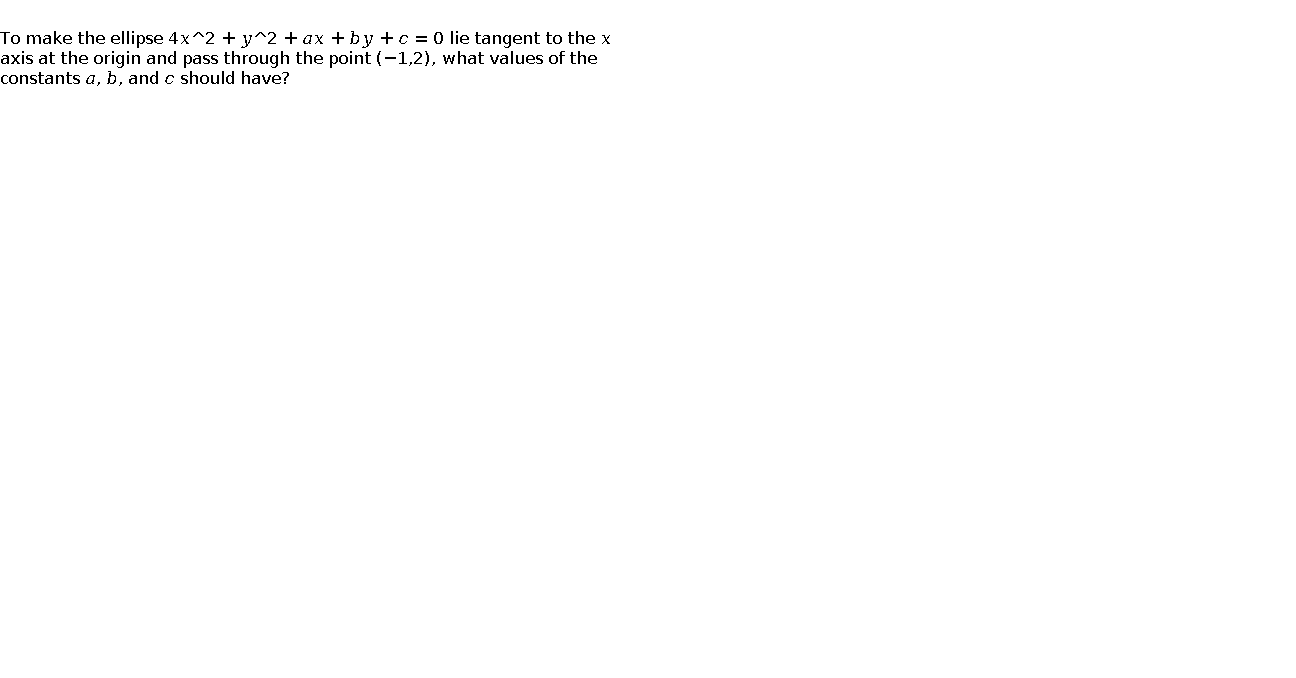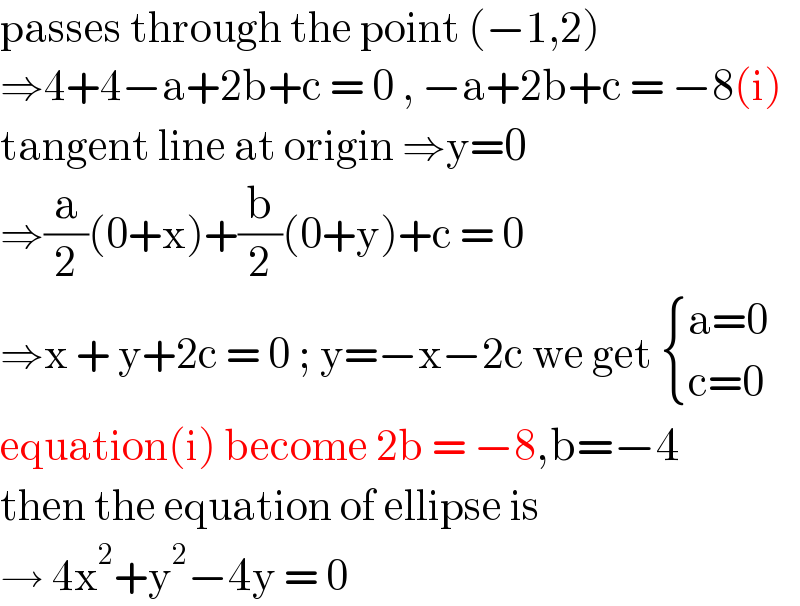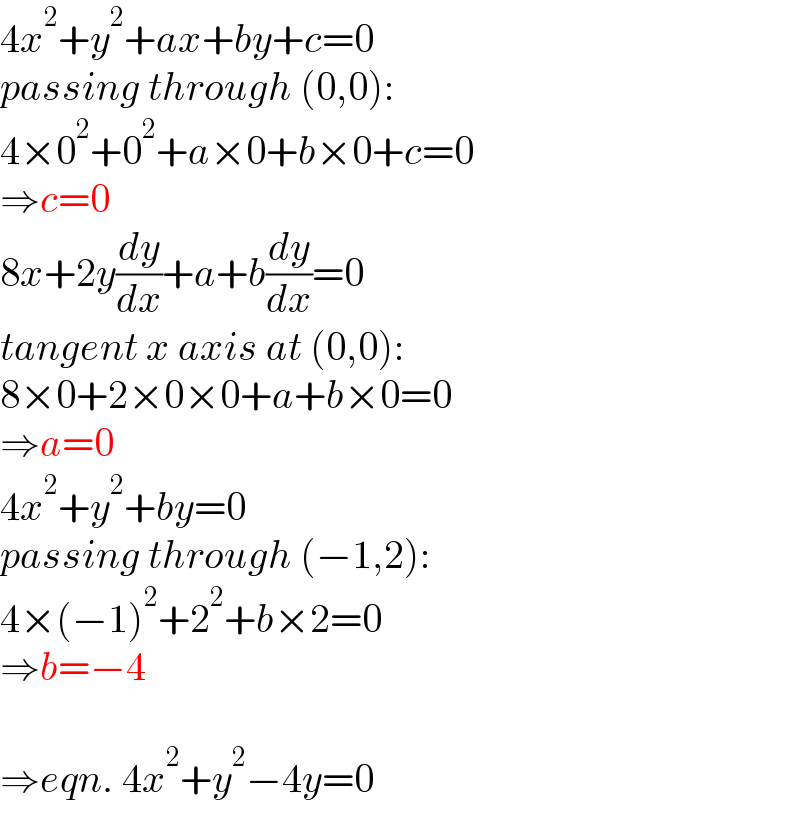
Question Number 135747 by liberty last updated on 15/Mar/21

$$ \\ $$ To make the ellipse 4��^2 + ��^2 + ���� + ���� + �� = 0 lie tangent to the �� axis at the origin and pass through the point (−1,2), what values of the constants ��, ��, and �� should have?\\n
Answered by EDWIN88 last updated on 15/Mar/21

$$\mathrm{passes}\:\mathrm{through}\:\mathrm{the}\:\mathrm{point}\:\left(−\mathrm{1},\mathrm{2}\right) \\ $$ $$\Rightarrow\mathrm{4}+\mathrm{4}−\mathrm{a}+\mathrm{2b}+\mathrm{c}\:=\:\mathrm{0}\:,\:−\mathrm{a}+\mathrm{2b}+\mathrm{c}\:=\:−\mathrm{8}\color{mathred}{\left(}\mathrm{\color{mathred}{i}}\color{mathred}{\right)} \\ $$ $$\mathrm{tangent}\:\mathrm{line}\:\mathrm{at}\:\mathrm{origin}\:\Rightarrow\mathrm{y}=\mathrm{0} \\ $$ $$\Rightarrow\frac{\mathrm{a}}{\mathrm{2}}\left(\mathrm{0}+\mathrm{x}\right)+\frac{\mathrm{b}}{\mathrm{2}}\left(\mathrm{0}+\mathrm{y}\right)+\mathrm{c}\:=\:\mathrm{0} \\ $$ $$\Rightarrow\mathrm{x}\:+\:\mathrm{y}+\mathrm{2c}\:=\:\mathrm{0}\:;\:\mathrm{y}=−\mathrm{x}−\mathrm{2c}\:\mathrm{we}\:\mathrm{get}\:\begin{cases}{\mathrm{a}=\mathrm{0}}\\{\mathrm{c}=\mathrm{0}}\end{cases} \\ $$ $$\mathrm{\color{mathred}{e}\color{mathred}{q}\color{mathred}{u}\color{mathred}{a}\color{mathred}{t}\color{mathred}{i}\color{mathred}{o}\color{mathred}{n}}\color{mathred}{\left(}\mathrm{\color{mathred}{i}}\color{mathred}{\right)}\color{mathred}{\:}\mathrm{\color{mathred}{b}\color{mathred}{e}\color{mathred}{c}\color{mathred}{o}\color{mathred}{m}\color{mathred}{e}}\color{mathred}{\:}\mathrm{\color{mathred}{2}\color{mathred}{b}}\color{mathred}{\:}\color{mathred}{=}\color{mathred}{\:}\color{mathred}{−}\mathrm{\color{mathred}{8}},\mathrm{b}=−\mathrm{4} \\ $$ $$\mathrm{then}\:\mathrm{the}\:\mathrm{equation}\:\mathrm{of}\:\mathrm{ellipse}\:\mathrm{is}\: \\ $$ $$\rightarrow\:\mathrm{4x}^{\mathrm{2}} +\mathrm{y}^{\mathrm{2}} −\mathrm{4y}\:=\:\mathrm{0}\: \\ $$
Answered by mr W last updated on 15/Mar/21

$$\mathrm{4}{x}^{\mathrm{2}} +{y}^{\mathrm{2}} +{ax}+{by}+{c}=\mathrm{0} \\ $$ $${passing}\:{through}\:\left(\mathrm{0},\mathrm{0}\right): \\ $$ $$\mathrm{4}×\mathrm{0}^{\mathrm{2}} +\mathrm{0}^{\mathrm{2}} +{a}×\mathrm{0}+{b}×\mathrm{0}+{c}=\mathrm{0} \\ $$ $$\Rightarrow{\color{mathred}{c}}\color{mathred}{=}\mathrm{\color{mathred}{0}} \\ $$ $$\mathrm{8}{x}+\mathrm{2}{y}\frac{{dy}}{{dx}}+{a}+{b}\frac{{dy}}{{dx}}=\mathrm{0} \\ $$ $${tangent}\:{x}\:{axis}\:{at}\:\left(\mathrm{0},\mathrm{0}\right): \\ $$ $$\mathrm{8}×\mathrm{0}+\mathrm{2}×\mathrm{0}×\mathrm{0}+{a}+{b}×\mathrm{0}=\mathrm{0} \\ $$ $$\Rightarrow{\color{mathred}{a}}\color{mathred}{=}\mathrm{\color{mathred}{0}} \\ $$ $$\mathrm{4}{x}^{\mathrm{2}} +{y}^{\mathrm{2}} +{by}=\mathrm{0} \\ $$ $${passing}\:{through}\:\left(−\mathrm{1},\mathrm{2}\right): \\ $$ $$\mathrm{4}×\left(−\mathrm{1}\right)^{\mathrm{2}} +\mathrm{2}^{\mathrm{2}} +{b}×\mathrm{2}=\mathrm{0} \\ $$ $$\Rightarrow{\color{mathred}{b}}\color{mathred}{=}\color{mathred}{−}\mathrm{\color{mathred}{4}} \\ $$ $$ \\ $$ $$\Rightarrow{eqn}.\:\mathrm{4}{x}^{\mathrm{2}} +{y}^{\mathrm{2}} −\mathrm{4}{y}=\mathrm{0} \\ $$
Commented bymr W last updated on 15/Mar/21

